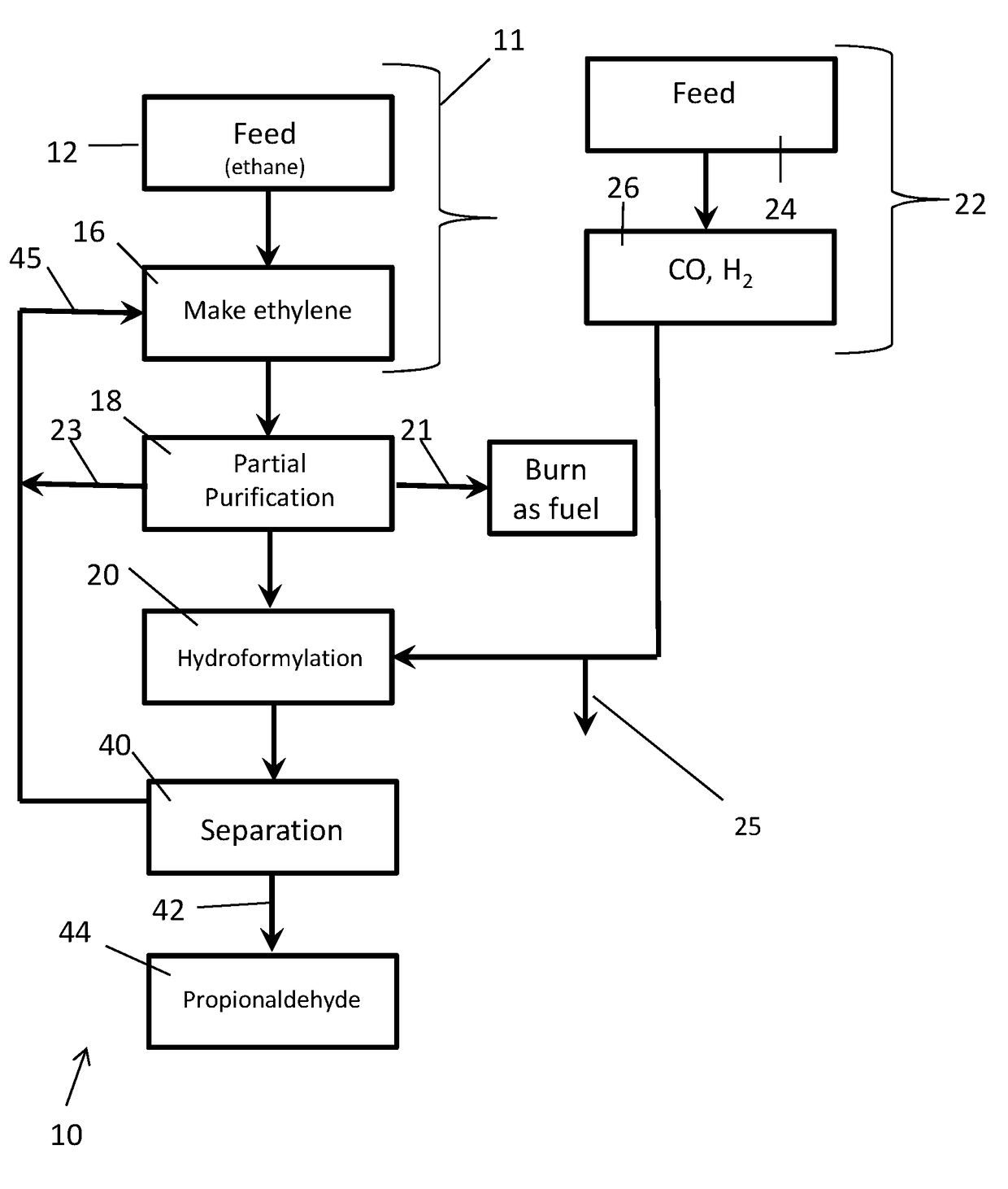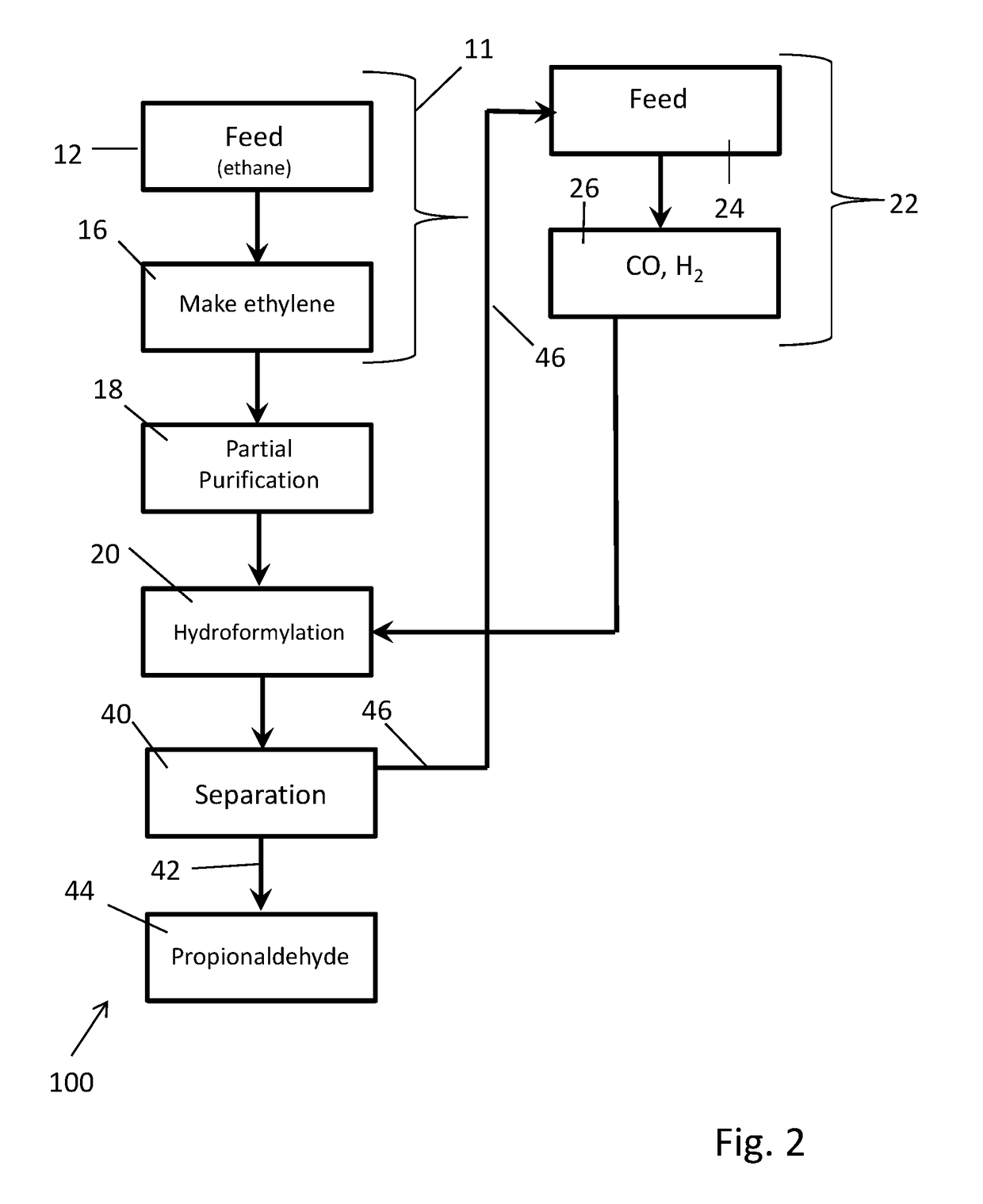Processes for making C3 products from ethylene and syngas using hydroformylation strategies
a technology of ethylene and syngas, which is applied in the direction of physical/chemical process catalysts, bulk chemical production, lighting and heating apparatus, etc., can solve the problems of increasing the shortage of c3 products such as 1-propanol and in particular propylene, and the inability to make c3 products from ethylene and syngas, so as to achieve effective use, increase efficiency, and reduce the effect of was
- Summary
- Abstract
- Description
- Claims
- Application Information
AI Technical Summary
Benefits of technology
Problems solved by technology
Method used
Image
Examples
example 1
[0144]Synthesis gas is produced from natural gas by existing processes well known in the art having a hydrogen to carbon monoxide mole ratio in the 1:1 to 3:1 range, preferably ˜2:1. Excess hydrogen is removed from the synthesis gas by existing processes to reduce the hydrogen to carbon monoxide ratio to about 1.03:1. The resulting synthesis gas is reacted with an enriched, partially purified ethylene product stream containing at least some (˜18%) ethane using a complex rhodium in complex combination with carbon monoxide and Triphenyl Phosphine containing catalyst system at 60° C. to 140° C. range to produce propionaldehyde and some propanol. (U.S. Pat. No. 3,527,809 & U.S. Pat. No. 4,148,830). The ethylene conversion is >90% of the contained ethylene. The condensed propionaldehyde and propanol, which is separated from ethane and any other gases, are further hydrogenated under pressure using in part the excess hydrogen removed above to produce propanol. The propanol is optionally pu...
example 2
[0145]In this example, a stream containing 85% ethylene, ˜14% ethane and 1% hydrogen are fed together with 1.04:1 H2 / CO syngas to a staged commercially typical liquid phase hydroformylation reaction system containing propionaldehyde with a complex rhodium in complex combination with carbon monoxide and Triphenyl Phosphine containing catalyst system at 60° C. to 140° C. range to produce propionaldehyde and some propanol. The crude liquid product stream is separated from the gas stream. Propionaldehyde is distilled from the concentrated catalyst stream and hydrogenated as is in the liquid and / or gas phases using catalysts typical to those known in the art to produce propanol. Propanol is separated from ethane other gases, purified for sale and / or subjected to dehydration to produce propylene. Ethane as well as other gases are optionally purified for recycle, burned as fuel and or fed to the synthesis gas unit. Ethylene conversion exceeds 80% of theoretical after the 1st stage and exce...
example 3
[0146]In this example crude ethylene is produced in total or in part via dehydration of ethanol produced from bio-mass. Syngas (H2 / CO 2:1) is also optionally produced in part or total from biomass through gasification or through reforming of methane or partial oxidation produced from biomass through biodegradation. Carbon dioxide and other acidic by-products are optionally removed from the synthesis gas using the carbon dioxide removal system. The resulting relatively pure ethylene feed stream containing >95% ethylene based on total carbon content, is co mixed with synthesis gas having a hydrogen to carbon monoxide mole ratio of ˜1.03:1 and subjected to the hydro-formylation reaction system using a catalyst system as described in U.S. Pat. No. 3,527,809 or U.S. Pat. No. 4,885,401 dissolved in propionaldehyde under pressure and at a temperature of 75° C. to 125° C. Over 98% of the contained ethylene is converted to produce a mixture of propionaldehyde and some propanol employing a mu...
PUM
| Property | Measurement | Unit |
|---|---|---|
| Fraction | aaaaa | aaaaa |
| Percent by mass | aaaaa | aaaaa |
| Percent by mass | aaaaa | aaaaa |
Abstract
Description
Claims
Application Information
 Login to View More
Login to View More - R&D
- Intellectual Property
- Life Sciences
- Materials
- Tech Scout
- Unparalleled Data Quality
- Higher Quality Content
- 60% Fewer Hallucinations
Browse by: Latest US Patents, China's latest patents, Technical Efficacy Thesaurus, Application Domain, Technology Topic, Popular Technical Reports.
© 2025 PatSnap. All rights reserved.Legal|Privacy policy|Modern Slavery Act Transparency Statement|Sitemap|About US| Contact US: help@patsnap.com



